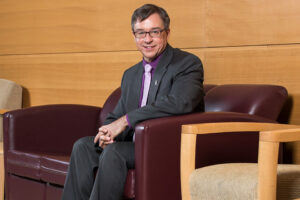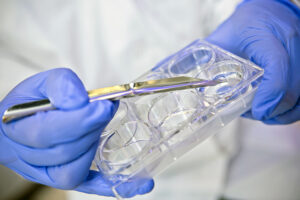MPower Day Highlights Impact, Innovation
Posted 3/9/18 on UMB News
“In this month alone, about 200 babies will be born in Maryland with opioids in their bodies,” said Asaf Keller, PhD, addressing a crowd of legislators, students, faculty, and staff at the University of Maryland Strategic Partnership: MPoweringthe State Advocacy Day in Annapolis on March 6, 2018.

State Sen. Adelaide Eckardt (R-Caroline, Dorchester, Talbot and Wicomico Counties) tries a virtual reality display at MPower Day.
The day was designed to highlight the innovation and impact that collaborative research between the University of Maryland, Baltimore (UMB) and the University of Maryland, College Park (UMCP) has had on solving important problems for the people of Maryland and the nation.
More than 20 diverse programs represent the University of Maryland Strategic Partnership, and each would be unattainable or difficult to achieve if UMB or UMCP acted independently of one another. “We have a great partnership,” said UMB President Jay A. Perman, MD. “It’s like Wallace Loh says, 1 and 1 equals 3 or 4,” he continued, referencing UMCP President Wallace D. Loh, PhD, JD.
Opioid Use Disorders Collaborative Research Program
Keller, professor, University of Maryland School of Medicine (UMSOM) at UMB, and his partner, Eric Wish, PhD, associate professor and director of the Center for Substance Abuse Research at UMCP, head up the Opioid Use Disorders Collaborative Research Program. The partnership leverages the sizable strengths and complementary missions of both institutions to advance interdisciplinary research, create opportunities for students, spark economic development, and solve important problems for the people of Maryland.
In the case of Keller and Wish, the problem is opioid abuse, and both researchers are dedicated to finding practical solutions to address the epidemic that kills more than 250 Marylanders a month.
A particularly devastating aspect of the crisis is treating babies born to mothers who abuse opioids.
The condition, known as Neonatal Abstinence Syndrome (NAS), causes newborns to display symptoms similar to those of a heroin addict going through withdrawal, including tremors, seizures, nausea, and diarrhea. “Most of them (babies) will be miserable,” Keller said.
The Opioid Use Disorders Collaborative Research Program also is fighting the current drug epidemic by educating physicians, medical students, and those in the dental field to identify at-risk patients and by helping to develop safe prescribing policies for pain medication. The education extends to patients as well, with the implementation of voluntary tapering programs designed to slowly wean users off of addictive drugs.
Finally, the program is analyzing urinalysis results and medical records from patients admitted to emergency rooms for a suspected drug overdose to better understand the patterns of opioid and other drug use.
Wish, who has been studying the effects of drug abuse for 28 years, said the opioid program’s work is important and will lead to solutions. “I think we’re going to have a lot of great findings that will lead to more sane policy in the area of drugs,” he said.
Maryland Blended Reality Center
The opioid group also is collaborating with the Maryland Blended Reality Center (MBRC) to reduce dependence on drugs to treat pain. The MBRC, a collaboration among UMB, UMCP, and UMMC, strives to improve the lives of Marylanders by developing augmented and virtual reality technology for medical and health care applications. One of the center’s four main thrusts is non-opioid pain management through immersive environments that show promise in distracting patients and decreasing the need for opioids during invasive procedures. The therapy involves putting on a headset that immerses the patient in a virtual world of their choosing to induce relaxation and distraction from pain. Choices include a mediation room, a beach, a video game, and even an opera performance.
The center’s principals include the R Adams Cowley Shock Trauma Center with co-director and UMSOM professor Sarah Murthi, MD, and the College of Computer, Mathematics & Natural Sciences (CMNS) in College Park with co-director and professor Amitabh Varshney, PhD.
In addition to providing alternative therapy for opioids, the MBRC is developing the next generation of medical education with interactive blended reality modules designed to teach gross anatomy dissection. Varshney’s computer science team in College Park has developed a method to film a gross anatomy dissection in 3-D so that students can have an immersive experience away from the dissection lab.
According to Murthi, Varshney’s team is breaking down the gross anatomy dissection into modules “so that more than just medical students can experience the immersive awesomeness of gross anatomy dissection.”
State Sen. Adelaide Eckardt (R-Caroline, Dorchester, Talbot, and Wicomico counties) was one of numerous attendees to don virtual reality goggles at the MBRC’s popular interactive display at Advocacy Day. Eckardt, a graduate of the University of Maryland School of Nursing, was immediately enveloped in a 360-degree video scenario of a Maryland State Police helicopter landing on the helipad at Shock Trauma to transport a crash victim to the emergency room.
“Is this a real patient?” she marveled, as Murthi explained the training possibilities of the video.
“I’m a nurse, so I love it,” Eckardt said.
Other areas of focus include critical care patient diagnostics that allow health care providers to interact more directly with patients and training police to identify and combat implicit bias that can affect interactions with the public. Researchers are adapting virtual environments to help police understand their biases. Prince George’s County police began the training March 6, the same day Varshney and Quinlan were presenting in Annapolis.
“We have created virtual reality scenarios of white, black, Asian-Americans, and Latinos coming in and addressing the police officers,” Varshney said. “How do officers react? That self-awareness, we believe, will be very critical in helping bridge the divides between various communities.”
Center for Sports Medicine, Health and Human Performance
Housed in the new Cole Field House in College Park, the Center for Sports Medicine, Health and Human Performance (CSMHHP) increases access to world-class sports medicine and occupational health services and advances the discovery of innovative solutions to improve human health, performance, and injury prevention and recovery.
UMSOM professor Alan I. Faden, MD, and UMCP professor Elizabeth Quinlan, PhD, are the scientific co-directors of CSMHHP, dedicated to researching traumatic brain injury (TBI), a major health problem in the United States with 3-4 billion cases per year and more than $100 million in costs per year.
“The overall goal is to better understand traumatic brain injury and a number of novel techniques and approaches harnessing the exceptional strengths in TBI and spinal cord injury both clinically and experimentally at the University of Maryland, Baltimore with the excellent strengths in complementary areas in computer science, engineering, and the physical and biological sciences at College Park,” Faden said.
Their multilevel research begins at the molecular level with studies to understand how molecules in the brain respond to therapy. Researchers also will make use of the multimodal imaging capacity housed in Cole Field House, which will allow them to track initial and long-term responses to therapy. The center also is studying the synergistic positive effects of nontraditional treatments such as intermittent fasting.
“We’re also interested in incorporating traditional responses to brain injury with some of the newer approaches that are based on findings by faculty in College Park and UMB that demonstrate that manipulations of diet, exercise, and cognitive function help to promote recovery from brain injury,” Quinlan noted.
State Sen. Cheryl Kagan (D-Montgomery County), one of several legislators who attended the event, was immediately drawn to a display outlining the work of the Maryland Cochlear Implant Center of Excellence, which combines the research and educational strengths of UMCP with surgical and clinical expertise from UMMC and UMSOM to provide cutting-edge care for people with hearing loss.
“I’m always interested in learning about dynamic new innovations and developments in the state,” Kagan said. “I’ve been working on 911 issues for several years, and as we shift to next-gen 911, it’s important to understand the issues that those who are deaf or hard of hearing are facing.”
To learn more about the University of Maryland Strategic Partnership, visit: https://mpower-dev.umbaltimore.com.



